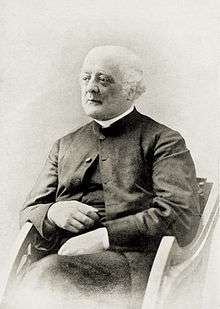Frederick Ouseley
| Sir Frederick Ouseley, Bt | |
|---|---|
 | |
| Born |
August 12, 1825 London |
| Died | 6 April 1889 (aged 63) |
| Era | Romantic |
| Notable work | List of Works |
Sir Frederick Arthur Gore Ouseley, 2nd Baronet (12 August 1825 – 6 April 1889) was an English composer, organist, musicologist and priest.
Biography
He was born in London, the son of Sir Gore Ouseley, and manifested an extraordinary precocity in music, composing an opera (L'Isola disabitata) at the age of eight years. In 1844, having succeeded to the baronetcy, he entered at Christ Church, and graduated BA in 1846 and MA in 1849. He was ordained in the latter year, and, as curate of St. Paul's Church, Knightsbridge, served the parish of St. Barnabas, Pimlico, until 1851.[1]
Throughout his life, he experienced a social conflict between his aristocratic heritage and his interest in the performance of Anglican church music, an activity which was seen as beneath someone of his stature. In 1850 he took the degree of Mus.B. at the University of Oxford, and four years afterwards that of Mus.D., his exercise being the oratorio The Martyrdom of St Polycarp. He was Heather Professor of Music at Oxford from 1855 to 1889. In 1856 Ouseley both founded and endowed with his own funds St Michael's College on the outskirts of Tenbury Wells, a choir school intended to serve as a model for Anglican church music. He also became the school's first Warden.[2]
Ouseley's works, which are little known today, include a second oratorio, Hagar (Hereford, 1873), a great number of services and anthems, cantatas, chamber music, organ pieces and songs. Among his instructional treaties on harmony, counterpoint, fugue, and composition are Harmony (1868) and Counterpoint (1869) and Musical Form (1875).[1]
He also added a series of chapters on English music to the English translation of Emil Naumann's History of Music, the subject having been practically ignored in the German treatise.[1]
Ouseley died in Hereford, where he had been precentor at Hereford Cathedral since 1855. Probably his most notable student was Sir John Stainer.
Works
Choral
[unfinished]
- Anthems:
- All the kings of the earth
- And there was a pure river of Water of life
- And there was a war in heaven
- Ascribe ye greatness
- Awake, thou that sleepest
- Behold, how good and joyful
- Behold now, praise the Lord
- Be merciful unto me
- Blessed be the Lord God of Israel
- Blessed be Thou
- Blessed is he whose unrighteousness
- Blessed is the man
- Christ is risen from the dead
- Except the Lord build the house
- From the rising of the sun
- Give thanks, O Israel
- Great is the Lord
- Happy is the man
- Haste Thee, O God
- How goodly are the tents
- Is it nothing to you
- Jerusalem on high
- O Saviour of the world
- Services
- Evening Service in B flat
- Evening Service in E flat
- Miscellaneous
- Gloria in D
- Te Deum in D
- Te Deum in F
- Hymn tunes
- Contemplation (When all thy mercies, O my God)
- Hereford (When wounded sore the stricken heart)
- Bewdley (Children of the heavenly King)
References
- 1 2 3 Chisholm 1911.
- ↑ Tenbury Wells and the Teme Valley, 2007, p10
- Attribution
 This article incorporates text from a publication now in the public domain: Chisholm, Hugh, ed. (1911). "Ouseley, Sir Frederick Arthur Gore". Encyclopædia Britannica (11th ed.). Cambridge University Press.
This article incorporates text from a publication now in the public domain: Chisholm, Hugh, ed. (1911). "Ouseley, Sir Frederick Arthur Gore". Encyclopædia Britannica (11th ed.). Cambridge University Press.
External links
- Free scores by Frederick Ouseley in the Choral Public Domain Library (ChoralWiki)
- Free scores by Frederick Ouseley at the International Music Score Library Project
- St Michael's College Society
- The Ouseley Church Music Trust